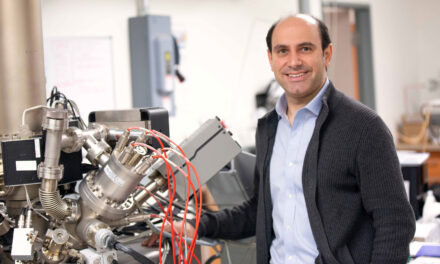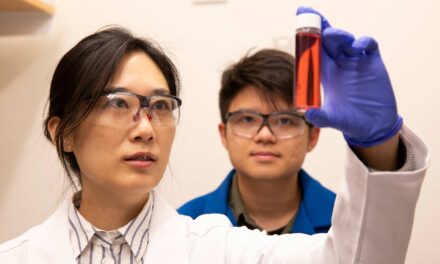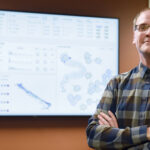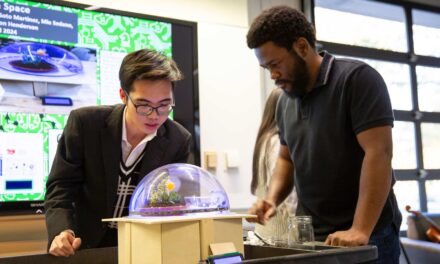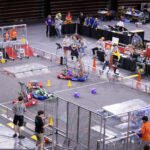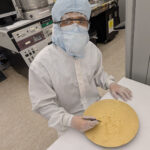
Pursuit of portable 3-D ultrasound technology advances brings award

ASU electrical engineering professor Chaitali Chakrabarti is doing research that promises to provide a high-quality reliable mobile ultrasound device. Photo: Jessica Slater/ASU
Posted April 10, 2013
A report on research to develop a more portable, high-quality device to produce ultrasound imaging for medical diagnosis has earned recognition for Arizona State University electrical engineer Chaitali Chakrabarti and her collaborators.
Chakrabarti is a professor in the School of Electrical, Computer and Energy Engineering, one of ASU’s Ira A. Fulton Schools of Engineering. She and her students Ming Yang and Siyuan Wei shared the Best Paper Award for the report at the 2013 International Symposium on High-Performance Computer Architecture in Shenzhen, China, with colleagues Richard Sampson and Thomas Wenisch of the University of Michigan.
Their paper, “Sonic Millip3De: Massively Parallel 3D-Stacked Accelerator for 3D Ultrasound,” focuses on the team’s work on development of a portable ultrasound device that in three to four years will be capable of operating at a five-watt power budget while still producing high-quality images.
It will be the first of its kind to combine the imaging quality of large ultrasound machines with the convenience of a handheld device.
“Today you have many portable ultrasound devices but the imaging quality is not good, primarily because they have to cut corners to make it portable and to meet the power budget,” Chakrabarti explains.
To achieve high-quality imaging with a low-power budget requires codesigning algorithms and hardware. Chakrabarti and two electrical engineering graduate student researchers – doctoral student Ming Yang, and master’s student Siyuan Wei – are working primarily on algorithms that improve the image quality without increasing the computation load.
Chakrabarti’s partners at the University of Michigan – Sampson, a doctoral student and Wenisch, a professor of electrical engineering and computer science – are focusing on the architecture of the device and how to make it power-efficient.
The architecture makes use of a three-dimensional die-stacking technology that splits the processing across multiple silicon layers to maintain a small footprint. It creates a volumetric image that is easier to interpret diagnostically, as opposed to the two-dimensional “slice” images that require a trained technician to understand and interpret.
The device is designed to make ultrasound accessible outside of clinics and facilities that specialize in medical imaging. By producing a portable, high-quality tool, Chakrabarti says, individual medical practices would have immediate on-site access to high-quality ultrasound imaging.
“We are also thinking that a first responder to a medical emergency could use it to take images, do some initial diagnostic interpretation and send the information to a physician to view,” she says.
After two years on the project, the team is producing its first prototype. Energy usage has been reduced to 12 watts, and the researchers are confident in another three to four they can further reduce it to a five-watt power budget while still producing images that match the quality of existing tethered ultrasound devices.
“It has to perform on par with what’s out there,” Chakrabarti says. “Nobody is going to use the system if the imaging quality is bad.”
Chakrabarti’s accomplishments include three previous best paper awards for various research projects:
The International Conference on Embedded Computer Systems: Architectures, Modeling and Simulation (SAMOS) 2007 award for “The Next Generation Challenge for Software Defined Radio” The International Symposium on Microarchitecture 2008 award for “From SODA to Scotch: The Evolution of a Wireless Baseband Processor”
The Signal Processing Systems 2010 award for “A New Parallel Implementation for Particle Filters and its Application to Adaptive Waveform Design”
Chakrabarti is also being recognized for her career achievements by her college alma mater, the University of Maryland. She will be awarded the Distinguished ECE Alumni Award from the university’s Electrical and Computer Engineering department this spring.
The alumni award recognizes those who have “made extraordinary contributions to advancing electrical and computer engineering research, technology, and education.”
Chakrabarti earned her doctoral degree in electrical engineering from University of Maryland in 1990.
Written by Natalie Pierce and Joe Kullman
Media Contact:
Joe Kullman, [email protected]
(480) 965-8122
Ira A. Fulton Schools of Engineering


